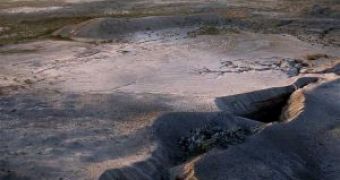In the future, there will not be one Africa, but two.
It's a process we can see in front of our eyes: Ethiopia's rift valley is slowly tearing itself apart and getting wider.
An international 28-strong team led by University of Leeds geophysicist Dr Tim Wright will investigate the seismic phenomena occuring in the remote Afar desert of Northern Ethiopia. It's exactly here that two continental shelves, the African and Arabian plates, collide and are tearing apart the continent.
The two Africas are coming off with about 16 mm annually, at about the same speed at which your fingernails grow, but they sometimes experience bursts of the accumulated underground pressure, translated in cataclysmic activity. The biggest recent cataclysm took place in September 2005, when hundreds of deep crevices emerged within a few weeks, and some territories sank eight metres (25 feet) almost overnight.
One crack was filled with more than two billion cubic meters of magma (rising molten rock), forcing further apart the African and Arabian tectonic plates.
This is unique on Earth. "Much of the activity between the continental shelves takes place deep underwater at the mid-ocean ridges. Ethiopia is the only place on the planet where we can see a continent splitting apart on dry land", said Dr. Wright.
The team will employ satellite radar imaging, GPS, seismometers, and other geophysical and geochemical techniques to assess how new ground emerges, to monitor the crust's movements and the properties of rock and magma below the surface. "In its simplest form, you are taking two snapshots of the same place, separated by a period of time, to see how far they have moved apart."
A 3D computer model of how magma moves through the Earth's crust, breaking continents, will be made.
Even if the gap left by the Rift is being filled with magma, which cools forming new land, scientists have already calculated that in around one million years the Red Sea will flood the sinking region, splitting Africa in two parts. "It's very exciting because we're witnessing the birth of a new ocean," said Dr Wright.
"In geological terms, a million years is the blink of an eye. We don't precisely know what is going to happen, but we believe that it may turn parts of Northern Ethiopia and Eritrea into an island, before a much larger land mass - the horn of Africa - breaks off from the continent."
Much of the team's work will be on the ground in the Afar region of Ethiopia, also known as the Danakil depression. Afar depression is an inhospitable, but beautiful desert. "Afdera, one of the towns in the region, is the hottest continuously-occupied place on the planet," said Dr Wright. "Temperatures can approach 60 degrees centigrade during the summer months, so we tend to go in the winter when it's that bit cooler - although it still gets to 45C."
"We will be training Ethiopian scientists in the use of satellite and radar technology - skills they will be able to continue to use long after this program has ended."

 14 DAY TRIAL //
14 DAY TRIAL //